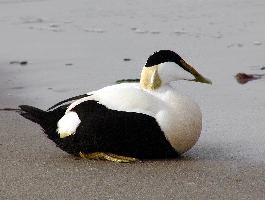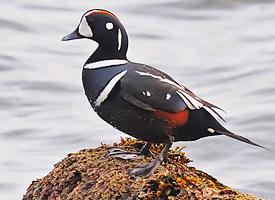
Description de l'animal
The Common Shelduck (Tadorna tadorna) is a striking and distinctive waterfowl that belongs to the bird family Anatidae, which includes ducks, geese, and swans. This species exhibits a unique combination of colors and patterns that make it easily recognizable among other waterfowl.Adult Common Shelducks are medium to large birds, typically measuring between 58 to 67 centimeters in length, with a wingspan that can reach up to 110 to 133 centimeters. They possess a robust body, a relatively long neck, and a prominent, rounded head. One of the most notable features of the Common Shelduck is its bill, which is bright red in adults, contrasting sharply with their predominantly white plumage. The males (drakes) and females (hens) exhibit sexual dimorphism, although it is relatively subtle compared to other species. Both sexes have a similar color pattern, but the drake usually boasts a more vibrant hue and a prominent knob at the base of the bill during the breeding season.
The plumage of the Common Shelduck is a striking combination of white, chestnut, and green. The bird's body is primarily white, with a chestnut band that wraps around the breast and merges into the back. The wings are tipped with glossy green-black feathers, which are most visible in flight. The tail is also black, creating a sharp contrast with the white body. The legs and feet are of a pinkish hue, adding to the bird's colorful appearance.
Common Shelducks are found across a wide range, extending from western Europe and northwest Africa across to western China. They prefer coastal habitats, such as estuaries, tidal flats, and salt marshes, although they can also be found in inland wetlands, lakes, and rivers. These birds are partial migrants, with northern populations moving southwards to warmer areas during the winter months.
The diet of the Common Shelduck primarily consists of small invertebrates, such as mollusks, crustaceans, and insects, which they forage from the mud with their specialized bills. They may also consume small amounts of plant material, including seeds and roots.
Breeding season for the Common Shelduck typically begins in late spring, when pairs form and select nesting sites. Unlike many other duck species, Common Shelducks often nest in burrows, which can be natural cavities or abandoned burrows of other animals, such as rabbits. The female lays a clutch of 6 to 12 eggs, which she incubates for about 30 days. The ducklings are precocial, meaning they are relatively mature and mobile shortly after hatching. They are led to water by their mother, where they begin to feed themselves.
The Common Shelduck plays an important role in its ecosystem, acting as both a predator of small invertebrates and as prey for larger predators. Its presence in wetland habitats also contributes to the health of these ecosystems, as it participates in the cycling of nutrients through its feeding activities.
In summary, the Common Shelduck is a captivating and colorful waterfowl species, known for its distinctive appearance and adaptable nature. It is a common sight in suitable habitats across its range, where it continues to fascinate birdwatchers and contribute to the biodiversity of wetland ecosystems.
Carte de répartition

Animaux similaires
Nouvelles photos d'animaux
Top 10 des animaux
- Dolphin gull (Leucophaeus scoresbii)
- Diana monkey (Cercopithecus diana)
- Moustached guenon (Cercopithecus cephus)
- Galápagos tortoise (Geochelone nigra complex)
- Japanese macaque (Macaca fuscata)
- Stone loach (Barbatula barbatula)
- Russian tortoise (Testudo horsfieldii)
- Greek tortoise (Testudo graeca)
- Common flying dragon (Draco volans)
- Vendace (Coregonus albula)


